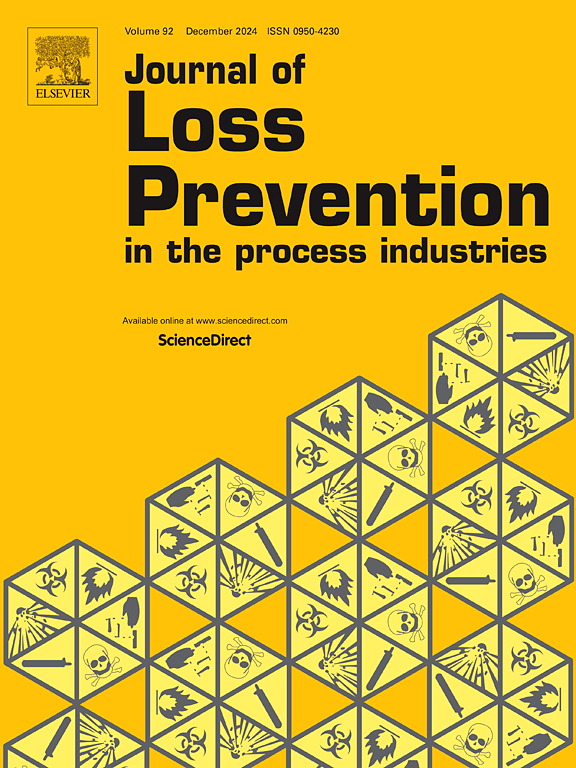Advances in hydrogen storage technologies
IF 3.6
3区 工程技术
Q2 ENGINEERING, CHEMICAL
Journal of Loss Prevention in The Process Industries
Pub Date : 2025-01-19
DOI:10.1016/j.jlp.2025.105561
引用次数: 0
Abstract
Gaseous hydrogen storage is the most mature technology for fuel cell vehicles. The main safety concern is the catastrophic consequences of tank rupture in a fire, i.e. blast waves, fireballs, and projectiles. This paper summarises research on the development and validation of the breakthrough microleaks-no-burst (μLNB) safety technology of explosion-free in any fire self-venting Type IV tanks that do not require a thermally-activate pressure relief device (TPRD). The invention implies the melting of the hydrogen-tight liner of the Type IV tank before the hydrogen-leaky double-composite wall loses load-bearing ability. Hydrogen then flows through the natural microchannels in the composites and burns in microflames or together with resin. The unattainable to competitive products feature of the technology is the ability to withstand any fire from smouldering to extreme impinging hydrogen jet fires. Innovative 70 MPa tanks made of carbon-carbon, carbon-glass, and carbon-basalt composites were tested in characteristic for gasoline/diesel spill fires with a specific heat release rate of HRR/A = 1 MW/m2. Standard unprotected Type III and IV tanks will explode in such intensity fire. The technology excludes hydrogen accumulation in naturally ventilated enclosures. It reduces the risk of hydrogen vehicles to an acceptable level below that of fossil fuel cars, including underground parking, tunnels, etc. The performance of self-venting tanks is studied for fire intervention scenarios: removal from fire and fire extinction by water. It is concluded that novel tanks allow standard fire intervention strategies and tactics. Self-venting operation of the 70 MPa tank is demonstrated in extreme jet fire conditions under impinging hydrogen jet fire (70 MPa) with huge HRR/A = 19.5 MW/m2. This technology excludes tank rupture in fires onboard trains, ships, and planes, where hazard distances cannot be implemented, i.e. provides an unprecedented level of life safety and property protection.
储氢技术的进展
气体储氢是燃料电池汽车最成熟的技术。主要的安全问题是储罐在火灾中破裂的灾难性后果,即冲击波、火球和弹丸。本文综述了在不需要热激活减压装置(TPRD)的任何火灾自排气型IV型储罐中实现无爆微漏(μLNB)安全的突破性技术的开发与验证。本发明涉及在漏氢双复合壁失去承载能力之前,将IV型储罐的密氢衬板熔化。然后氢通过复合材料中的天然微通道流动,并在微火焰中燃烧或与树脂一起燃烧。该技术的竞争产品无法企及的特点是能够承受从闷烧到极端撞击氢气喷射火灾的任何火灾。由碳-碳、碳-玻璃和碳-玄武岩复合材料制成的新型70 MPa储罐在汽油/柴油泄漏火灾中进行了特性测试,其比热释放率为HRR/ a = 1 MW/m2。标准的无保护的III型和IV型坦克会在如此强烈的火力下爆炸。该技术排除了氢气在自然通风的外壳中积聚。它将氢燃料汽车的风险降低到低于化石燃料汽车的可接受水平,包括地下停车、隧道等。研究了自排气罐在灭火和水灭火两种火灾干预场景下的性能。结论是,新型坦克允许标准的火力干预策略和战术。在冲击氢射流火灾(70 MPa)条件下,以巨大的HRR/A = 19.5 MW/m2,演示了70 MPa储罐在极端射流火灾条件下的自排气运行。该技术排除了火车、船舶和飞机上发生火灾时油罐破裂的可能性,这些情况下无法实现危险距离,也就是说,提供了前所未有的生命安全和财产保护。
本文章由计算机程序翻译,如有差异,请以英文原文为准。
求助全文
约1分钟内获得全文
求助全文
来源期刊
CiteScore
7.20
自引率
14.30%
发文量
226
审稿时长
52 days
期刊介绍:
The broad scope of the journal is process safety. Process safety is defined as the prevention and mitigation of process-related injuries and damage arising from process incidents involving fire, explosion and toxic release. Such undesired events occur in the process industries during the use, storage, manufacture, handling, and transportation of highly hazardous chemicals.

 求助内容:
求助内容: 应助结果提醒方式:
应助结果提醒方式:


